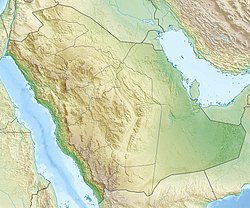Mescid-i Nebevi
Peygamber Mescidi olarak da bilinir.
- Tür: Cami
- Kültür: Abbasi, Dört Halife, Emevi, Memlük, Osmanlı
- Yüzyıl: 7. yy
- Bölge: Suudi Arabistan, Medine
| Prophet's Mosque | |
|---|---|
Al-Masjid An-Nabawī (ٱلْمَسْجِد ٱلنَّبَوِي) | |
A picture of the mosque from the south with the city of Medina in the background | |
| Religion | |
| Affiliation | Islam |
| Rite | Ziyarah |
| Leadership |
|
| Location | |
| Location | Al-Haram, Al-Medinah 42311, Al-Hejaz |
| Country | |
| Administration | General Presidency of Haramain |
| Geographic coordinates | 24°28′6″N 39°36′39″E / 24.46833°N 39.61083°E |
| Architecture | |
| Type | Religious architecture |
| Style | Islamic architecture |
| Founder | Muhammad |
| Date established | 623 CE (1 AH) |
| Specifications | |
| Capacity | 1,000,000[1] |
| Minaret(s) | 10 |
| Minaret height | 105 m (344 ft) |
| Inscriptions | Verses from the Quran and the names of Allah and Muhammad |
| Website | |
| wmn | |
The Prophet's Mosque (Arabic: ٱلْمَسْجِد ٱلنَّبَوِي, romanized: al-Masjid an-Nabawī, lit. 'Mosque of the Prophet') is the second mosque built by the Islamic prophet Muhammad in Medina, after that of Quba, as well as the second largest mosque and holiest site in Islam, after the Masjid al-Haram in Mecca, in the Saudi region of the Hejaz.[2] The mosque is located at the heart of Medina, and is a major site of pilgrimage that falls under the purview of the Custodian of the Two Holy Mosques.
Muhammad himself was involved in the construction of the mosque. At the time, the mosque's land belonged to two young orphans, Sahl and Suhayl, and when they learned that Muhammad wished to acquire their land to erect a mosque, they went to Muhammad and offered the land to him as a gift; Muhammad insisted on paying a price for the land because they were orphaned children. The price agreed upon was paid by Abu Ayyub al-Ansari, who thus became the endower or donor (Arabic: وَاقِف, romanized: wāqif) of the mosque, on behalf or in favor of Muhammad.[3] al-Ansari also accommodated Muhammad upon his arrival at Medina in 622.
Originally an open-air building, the mosque served as a community center, a court of law, and a religious school. It contained a raised platform or pulpit (minbar) for the people who taught the Quran and for Muhammad to give the Friday sermon (khutbah). Subsequent Islamic rulers greatly expanded and decorated the mosque, naming its walls, doors and minarets after themselves and their forefathers. After an expansion during the reign of the Umayyad caliph al-Walid I (r. 705–715), it now incorporates the final resting place of Muhammad and the first two Rashidun caliphs Abu Bakr (r. 632–634) and Umar (r. 634–644).[4] One of the most notable features of the site is the Green Dome in the south-east corner of the mosque,[5] originally Aisha's house,[4] where the tomb of Muhammad is located. Many pilgrims who perform the Hajj also go to Medina to visit the Green Dome.
In 1909, under the reign of Ottoman Sultan Abdul Hamid II, it became the first place in the Arabian Peninsula to be provided with electrical lights.[6] From the 14th century, the mosque was guarded by eunuchs, the last remaining guardians were photographed at the request of then-Prince Faisal bin Salman Al Saud, and in 2015, only five were left.[7][8] It is generally open regardless of date or time, and has only been closed to visitors once in modern times, as Ramadan approached during the COVID-19 pandemic in 2020.[9]
- ^ "WMN". Retrieved 26 November 2020.
- ^ Trofimov, Yaroslav (2008), The Siege of Mecca: The 1979 Uprising at Islam's Holiest Shrine, New York, p. 79, ISBN 978-0-307-47290-8
{{citation}}: CS1 maint: location missing publisher (link) - ^ "Masjid-e-Nabwi - IslamicLandmarks.com". IslamicLandmarks.com. 29 March 2014. Retrieved 26 June 2020.
- ^ a b Ariffin 2005, pp. 88–89, 109
- ^ Petersen, Andrew (11 March 2002). Dictionary of Islamic Architecture. Routledge. p. 183. ISBN 978-0-203-20387-3.
- ^ "The History of Electrical lights in the Arabian Peninsula". Archived from the original on 1 October 2015. Retrieved 15 June 2020.
- ^ "Portrait of Saeed Adam Omar". The British Museum. 2014. Retrieved 2022-04-29.
- ^ "'The Guardians' at Leighton House Museum". The Park Gallery. 2015-10-12. Retrieved 2022-04-29.
- ^ Farrell, Marwa Rashad, Stephen (24 April 2020). "Islam's holiest sites emptied by coronavirus crisis as Ramadan begins". Reuters. Retrieved 12 September 2020.
{{cite news}}: CS1 maint: multiple names: authors list (link)
✶ İlgili Yerler







